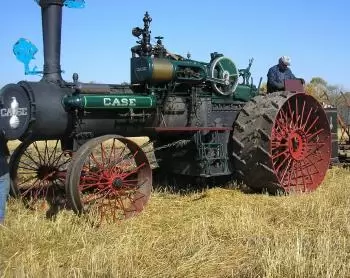
Steam engines have, throughout history, been a crucial source of power for a wide variety of applications in transportation, agriculture and construction.
Below are some of its main applications:
Marine applications and naval transport
In maritime transport, steam engines played a fundamental role in powering steamships , riverboats , steam yachts , among others. These steamships were crucial for trade and the transportation of people during the 19th and part of the 20th centuries, especially over long distances.
The first steam vessels, such as the paddlewheel boats that navigated the Mississippi River in the United States, marked the beginning of an era in which maritime transport underwent a revolution by becoming independent of the winds and ocean currents.
The steamboat is a prime example of the impact of steam on transportation. Powered by steam generated in a boiler, this type of ship was moved by paddle wheels or propellers. Although several engineers experimented with this technology, Robert Fulton is often credited with popularizing it in 1807 when he launched the Clermont , the first cost-effective and practical steamboat for passenger transport.
Before Fulton, other inventors had attempted to create steam-powered ships, but their designs failed to achieve significant commercial success. Fulton demonstrated that steam technology was not only viable, but could be a reliable method of large-scale transportation.
The first propeller-driven steamship was created in 1836 by the Austrian Josef Ressel , whose design was faster and more efficient than the rowing ships of the time. Years later, Isambard Kingdom Brunel designed the first modern passenger ship, the Great Britain , launched in 1843, which marked a turning point with its metal hull and axial propeller, surpassing previous paddle-driven models. This ship laid the foundations for the technology of the great ocean liners of the 20th century.
Railway transport: the steam locomotive
 In the railway field, the steam locomotive was one of the most revolutionary inventions of the 19th century. The first steam locomotive was designed by George Stephenson in 1814, and was used for the transport of goods and passengers. The development of the locomotive brought about a radical transformation in land transport, replacing animal traction systems and allowing the rapid development of railway networks worldwide.
In the railway field, the steam locomotive was one of the most revolutionary inventions of the 19th century. The first steam locomotive was designed by George Stephenson in 1814, and was used for the transport of goods and passengers. The development of the locomotive brought about a radical transformation in land transport, replacing animal traction systems and allowing the rapid development of railway networks worldwide.
This type of locomotive operated using a steam engine that drove pistons, which transmitted the motion to the train's wheels. With this technology, steam locomotives revolutionized long-distance transportation, allowing for a speed and load capacity that had never before been possible with traditional systems.
Steam trains enabled economic and social expansion by connecting cities and countries, facilitating trade and the movement of people.
Despite their great impact, steam locomotives began to be replaced in the 20th century by more efficient locomotives that used electric and internal combustion engines. Electric and diesel locomotives offered greater energy efficiency, lower maintenance, and greater power compared to steam engines. However, the legacy of the steam locomotive lives on in many tourist routes and historic railways, where these iconic machines continue to operate.
Agricultural applications: the steam tractor
One of the earliest uses of the steam engine in agriculture was as a traction engine for farm machinery. Steam tractors began to be used in the 19th century for plowing fields, threshing grain, and baling fodder. These early tractors, which were large and heavy, were primarily used in large-scale agriculture, where machinery capable of handling large areas of land was required.
The steam plow is an example of this application. Two steam tractors were placed at opposite ends of a field, and a steel cable pulled a plow from one side to the other. Although this system was efficient for its time, steam tractors were gradually replaced by internal combustion tractors, which were cheaper, lighter, and easier to maintain.
Modern tractors allow for greater maneuverability and efficiency, which explains their rapid adoption over steam engines.
Road transport: steam vehicles
In land transport, steam engines also found applications in vehicles such as vans , buses , tricycles and steam cars . During the last decades of the 19th century and the first decades of the 20th century, these vehicles experienced a certain boom before being displaced by internal combustion vehicles.
An iconic example was the Stanley Steamer steam car , which competed with gasoline-powered cars in the early 20th century. Although steam cars offered a smooth ride and great power, their technical complexity, the time required to heat the boiler, and their large size made them less attractive compared to gasoline-powered cars, which became the standard of the automotive industry.
Construction machinery: road rollers and excavators
In the construction industry, steam rollers and excavators were some of the first heavy machines powered by steam engines. These machines enabled significant advances in road and public works construction. Steam rollers, used to level and compact surfaces, played a crucial role in the development of modern infrastructure.
As in other sectors, steam engines were eventually replaced by diesel and electric machinery, due to their greater operational advantages.